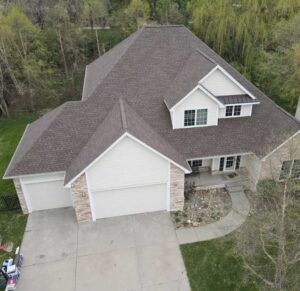If you’ve been researching premium, storm-hardened roofing that also checks the “eco-friendly” box, you’ve probably come across Euroshield®—a family of shingles and panels made primarily from recycled tires. Below is a straight-shooting guide to Euroshield: what it’s made of, how it handles hail, fire, heat, and wind, what styles exist, and the key pros/cons to consider before you decide.
What is Euroshield?
Euroshield is a rubber-based roofing system manufactured from roughly 95% recycled material—mostly crumb rubber derived from end-of-life tires. The idea is to turn a landfill problem into a long-lasting roof that mimics the look of cedar shakes or slate. euroshieldroofing.com+2euroshieldroofing.com+2
Product families & profiles typically include looks such as Ranchlands Shake, Beaumont Shake, Vermont Slate (and Vermont Slate HP), and Rundle Slate—all panelized to speed installation while delivering a deep, textured profile on the roof. euroshieldroofing.com+1
Hail performance (where Euroshield really shines)
- UL 2218 Class 4 Impact Rating across the line—the highest rating in that test method. In the UL test, a 2-inch steel ball is dropped from 20 feet; Euroshield shingles remained intact. That level of impact resistance may also qualify some homeowners for insurance discounts (ask your carrier). euroshieldroofing.com+1
- Hail-proof claims on select “HP” models: Euroshield reports that while all products are warrantied to withstand 2-inch hail, certain HP (Hail Proof) models (e.g., Beaumont or Vermont Slate HP) offer limited warranties up to 4 inches (and marketing content describes “any size” coverage for the first 20 years on HP). Always read the specific warranty for the exact terms. euroshieldroofing.com+2American Commercial Roofing+2
What this means in the real world (Missouri/Plains homeowners): If your home faces frequent hail events, Euroshield’s impact resistance is one of the strongest arguments for choosing it over standard asphalt.
Fire rating, heat, and wind
- Fire: Euroshield currently discusses its products as Class C in published materials, and the company has called for building-code changes to allow broader use in Class A fire zones. If you live in an area that requires Class A roofing (certain wildfire or urban-interface zones), verify local code acceptance and assembly options before you commit. euroshieldroofing.com
- Hot weather: Euroshield highlights good thermal behavior for hot climates (resisting UV, helping reduce heat transfer). While energy savings depend on color, attic ventilation, and insulation, the manufacturer positions rubber shingles as a durable, heat-tolerant option. euroshieldroofing.com+2euroshieldroofing.com+2
- Wind: Impact-rated shingles commonly pair with strong wind performance; however, wind ratings vary by product and install method. Ask your contractor for the specific wind warranty and installation requirements for the profile you choose. (General Class 4 context on wind is included here for orientation.) slavinhi.com
Styles, curb appeal, and warranty
- Looks: Profiles are designed to emulate hand-split cedar shake or quarried slate with deep shadow lines and thick edges—without the cupping, cracking, or spalling you get from real wood or stone. euroshieldroofing.com
- Warranty: Euroshield marketing references long-term warranties; many product pages and blogs cite 50-year coverage, while the company’s warranty page refers to “lifetime warranties.” Exact length and terms can vary by product and geography—review the written warranty for your SKU. euroshieldroofing.com+1
Sustainability & noise
- Waste diversion: Using a roof made from ~95% recycled rubber helps divert tires from landfills, a meaningful environmental benefit if sustainability ranks high for you. euroshieldroofing.com+1
- Quieter roof: Rubber can help dampen impact sound (like rain or acorns) compared with metal or thin asphalt—homeowners often notice a quieter interior during storms. (This is a common material property; if acoustic comfort matters, ask to see a local install or listen during rain.)
Installation & maintenance
- Installer experience matters: Rubber shingles cut and handle differently than asphalt. Choose a contractor trained on Euroshield fastening patterns, starter/hip-ridge components, flashings, and underlayment selection to meet local wind and—where required—fire code obligations. (Euroshield publishes panel sizes for layout efficiency.) euroshieldroofing.com
- Maintenance: Rubber doesn’t rot, split, or host insects like wood, and it’s not brittle like some synthetics. Periodic debris removal, gutter cleaning, and normal roof tune-ups are still smart practice—especially in tree-heavy lots.
Pros & cons at a glance
Pros
- Top-tier hail resistance (UL 2218 Class 4; select HP models with unique hail warranties). euroshieldroofing.com+1
- Sustainable (~95% recycled content). euroshieldroofing.com
- Premium look (shake or slate aesthetics). euroshieldroofing.com
- Potential insurance perks for Class 4 impact resistance—varies by insurer. euroshieldroofing.com
Cons
- Fire rating often Class C, which can limit use in some jurisdictions or require special assemblies; verify local code. euroshieldroofing.com
- Higher upfront cost than standard architectural asphalt (exact pricing varies by market; ask for a line-item quote).
- Availability/lead times and the need for an experienced installer with rubber systems. euroshieldroofing.com
Is Euroshield right for you?
Choose Euroshield if you want maximum hail resilience with premium curb appeal and sustainability. It’s especially compelling in hail-prone regions across Missouri and the Plains. If your home must meet Class A fire requirements, we’ll help you review code, assemblies, and alternatives that satisfy your AHJ (Authority Having Jurisdiction). euroshieldroofing.com
Euroshield vs. other premium synthetics
Other synthetic roofs (like polymer shakes/slates) can offer Class A fire ratings when installed to spec, which is important in certain zones; however, Euroshield’s rubber composition and hail-focused warranties are where it sets itself apart. Your best choice comes down to risk profile (hail vs. fire), aesthetics, and budget.
Thinking about Euroshield for your roof?
As a Missouri installer familiar with storm-hardening options, we can:
- Inspect your current roof and attic ventilation
- Model options (Euroshield vs. Class 4 asphalt vs. metal) around your hail risk and local code
- Provide a clean, apples-to-apples proposal with profiles, colors, and written warranty terms
Ready for a storm-resilient, sustainable roof? Get a Euroshield consultation and estimate—no pressure, just facts and numbers tailored to your home.


